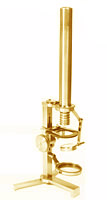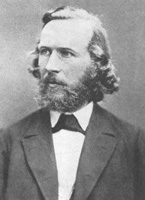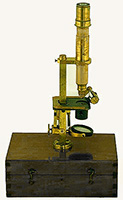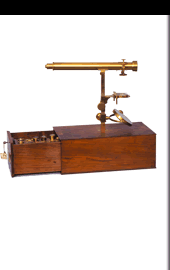Instruments
Small Achromatic Microscope
This microscope, which the Workshop Account Book indicates as for sale from 1835 on, was described in the Tome Douzième, Troisième Série, 1844, of the “Annales de Chimie et de Physique”: Description du petit microscope achromatique de
M. Amici, p. 117-120 (download pdf).
In the 1830s-’40s its price varied from 260 to 300 Francs, depending on the number of objectives and accessories which it contained, as compared to the 800 Francs which was the lowest price of the larger microscope.
 It was very favourably received by scientists and researchers after the success obtained at the Universal Exposition in Paris in 1855, where it was presented hors concours, supplied with strong object-glasses “properly modified so that they can be used with the immersion of the plane of the half sphere in water or poppy seed oil” (letter from Amici to O.F. Mossotti, dated 25 October 1855).
It was very favourably received by scientists and researchers after the success obtained at the Universal Exposition in Paris in 1855, where it was presented hors concours, supplied with strong object-glasses “properly modified so that they can be used with the immersion of the plane of the half sphere in water or poppy seed oil” (letter from Amici to O.F. Mossotti, dated 25 October 1855).
“In 1855, when the Jury on Microscopes at the Paris Exposition were comparing the rival instruments, Professor Amici brought a compound achromatic microscope, comparatively of small dimensions, which exhibited certain striæ in the test objects better than any of the instruments under examination. This superiority was produced by the introduction of a drop of water between the object and the object-glass” (Jabez Hogg, The microscope: its history, construction, and application, Third Edition, Routledge, London 1858, p. 12, nota).
In 1856 the Bohemian physician Wilhelm Dusan Lambl (1824-1895), who worked with Purkyne in Prague in Human Anatomy and Histology (his name is connected to the discovery of the Lamblia intestinalis), while on a trip to Italy stopped in Florence as well (cf. his Reisebericht 1856. Italien, “Vierteljahrschrift für die praktische Heilkunde”, I-1859). He was enthusiastic about the optics of Amici and immediately began promoting him abroad, as did the Batka brothers, also from Prague. They literally inundated the instrument maker with orders, in particular for the small achromatic microscope, to the point that it seems that the Bohemian capital was inseparably linked with the Amici microscope in those years. Lambl himself wrote in  a letter to Amici dated 21 March, 1859: “A young Russian who last year had purchased an Amici microscope from me went to introduce himself to Prof. Virchow while in Berlin. When this young scientist first pulled out your microscope, Virchow said: Aha, an Amici, you come from Prague!”
a letter to Amici dated 21 March, 1859: “A young Russian who last year had purchased an Amici microscope from me went to introduce himself to Prof. Virchow while in Berlin. When this young scientist first pulled out your microscope, Virchow said: Aha, an Amici, you come from Prague!”
The Workshop Account Book has an entry for 200 Francs on 9 July 1858 from Prof. Purkyne for a small microscope to be sent to him in Prague.
The Bohemian physiologist Jan Evangelista Purkyne (1787-1869), one of the most brilliant researchers of his time, after working as a Full Professor of Physiology and Pathology at Breslau for twenty-six years returned to Prague in 1849 as a Professor of Physiology. He became known for his work and many discoveries, some of epochal proportions, in every field of microscopic Physiology and Anatomy. He was the first to publicly demonstrate the idea of cell theory, as early as 1837, preceding Theodor Schwann by two years.
Technical sheet for the small microscope for Prof. Purkyne

Objective |
Magnification |
parts of the micrometer |
|
9 |
0'''.0277 |
|
25 over glass |
0'''.0100 |
|
33.8 under water |
0'''.0074 |
|
67 under water |
0.0037 |
The Workshop Account Book has an entry for 200 Francs in October1858 from Prof. Ehrenberg of Berlin for a small microscope “that he took with him as he came through”.
Christian Gottfried Ehrenberg (1795-1876), German physician, was one of the most important naturalists and probably the greatest micrographer of the nineteenth century. From 1839 he was a professor of Medicine at the University of Berlin and from 1842 Secretary of the Berlin Academy of the Sciences. In Zoology he was a promoter of the study of microscopic organisms, in particular of the infusorians.
Technical sheet of the small microscope purchased by Prof. Ehrenberg on his way through Florence. Price: 200 francs.
Objective over glass with 1st eyepiece |
140 times |
Scale = 0'''.018 per part |
ditto, under water |
360 times |
Scale = 0'''.007 |
ditto, under water |
650 times |
Scale = 0'''.0038 |
The divisions of Nobert could be seen wonderfully in the last group, that is, in the 15°.
The Workshop Account Book has an entry for 240 Francs on 23 February 1859 from Dr. Haeckel of Berlin for a 4 series Microscope.
 On his way through Florence going to Messina, twenty-five year old Ernst Haeckel (1834-1919) bought a small microscope with water immersion objective from Amici. This purchase, which Haeckel did not dare communicate immediately to his father due to high cost (cf. letter of 15 December 1859. Download pdf), was extraordinarily useful to Haeckel for his research on plankton, research subsequently published in the monograph
On his way through Florence going to Messina, twenty-five year old Ernst Haeckel (1834-1919) bought a small microscope with water immersion objective from Amici. This purchase, which Haeckel did not dare communicate immediately to his father due to high cost (cf. letter of 15 December 1859. Download pdf), was extraordinarily useful to Haeckel for his research on plankton, research subsequently published in the monograph
Die Radiolarien, Reimer, Berlin 1862 (http://www.zum.de/stueber/haeckel/radiolarien/). Haeckel’s thirteen months in Italy during 1859 and 1860 were fundamental in his life. On one hand he “obtained a great deal of knowledge of the animal world of the Mediterranean in this period, through the use of the microscope, and the scientific elaboration of these data will constitute the principle fulcrum of his research in Zoology. On the other hand, the systematic study of Radiolarians provided him with abundant material on which to apply Darwin’s evolutionary theory” (Rainer Brömer, Ernst Haeckel e gli italiani, in Haeckel e l’Italia. La vita come scienza e come storia, Brugine, Edizioni Centro Internazionale di Storia dello Spazio e del Tempo, 1993, p. 80 < Ernst Haeckel and the Italians, in Haeckel and Italy: Life as science and history >).
Technical sheet of the small microscope for Dr Ernst Haeckel of Berlin

Series |
Magnification |
Magnification |
Scale |
|
72 times |
108 |
0.0345 |
|
330 |
495 |
0.0076 |
|
380 |
570 |
0.0066 |
|
660 |
990 |
0.0038 |
The 2nd series over glass
The 3rd and 4th series under water.
 There is another important note. On 19 January, 1860 the Workshop Account Book has an entry for “200 Francs for the microscope purchased by E. Hartnack, optician in Paris successor to Oberheuser.” The German physicist Edmund Hartnack (1826-1891), who went to Paris as a mechanic in 1847, first with Rühmkorff, then with Oberhäuser, with whom he became a partner and then his successor, was among the first to introduce the immersion system of Amici (cf. the exchange of letters between them in A. Meschiari, Corrispondenza di G. B. Amici con ottici e meccanici < Buron, Chevalier, Duboscq, Ertel, Fraunhofer, Guinand e Feil, Hartnack, Lerebours, Merz, Nachet, Oberhaeuser >, “Atti della Fondazione Giorgio Ronchi”, 4/5-2000). Amici kept a note for himself about the little microscope which Hartnack purchased:
There is another important note. On 19 January, 1860 the Workshop Account Book has an entry for “200 Francs for the microscope purchased by E. Hartnack, optician in Paris successor to Oberheuser.” The German physicist Edmund Hartnack (1826-1891), who went to Paris as a mechanic in 1847, first with Rühmkorff, then with Oberhäuser, with whom he became a partner and then his successor, was among the first to introduce the immersion system of Amici (cf. the exchange of letters between them in A. Meschiari, Corrispondenza di G. B. Amici con ottici e meccanici < Buron, Chevalier, Duboscq, Ertel, Fraunhofer, Guinand e Feil, Hartnack, Lerebours, Merz, Nachet, Oberhaeuser >, “Atti della Fondazione Giorgio Ronchi”, 4/5-2000). Amici kept a note for himself about the little microscope which Hartnack purchased:
Small microscope with two series of object-glasses for Mr. E. Hartnack, successor to G.Oberhaeuser
Opticien 21 Place Dauphine. Paris
Series ![]() Under water relationship = 1 : 41
Under water relationship = 1 : 41
Series ![]() Under poppy seed oil and also olive oil
Under poppy seed oil and also olive oil
Aperture 145°. Perfect lenses without rings. I can see well, with sunlight, the striae of the grammatophora subtilissima prepared by Bourgogne.
Relationship object to image : : 1 : 62
External surface of Flint in the upper objective lens is concave.
The focal distance is discreet; it is not as thick as the glass which covers the grammatophora in my box.
The most powerful series would be of the 1st choice and for this reason the microscope is provided with only two series. Two holes in the box remain empty; they can contain two series which Mr. E. Hartnack will construct for himself.
Price agreed upon: 200 francs.
